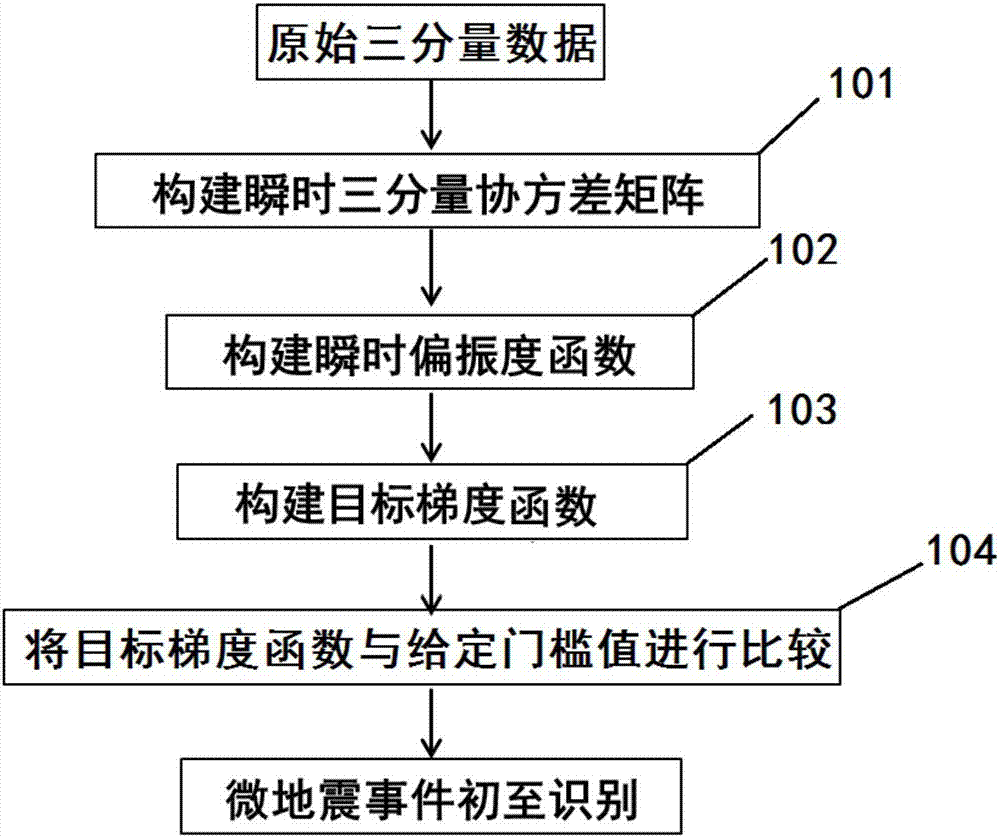Micro-seismic first arrival recognition method and device based on three-component polarization gradient
An identification method and three-component technology, which is applied in the directions of measuring devices, seismology, seismic signal processing, etc., can solve the problems of micro-seismic three-component data amplitude and polarity disorder and disorder
- Summary
- Abstract
- Description
- Claims
- Application Information
AI Technical Summary
Problems solved by technology
Method used
Image
Examples
Embodiment 1
[0020] figure 1 A flow chart of a microseismic first arrival identification method based on three-component polarization gradients according to an embodiment of the present invention is shown, the method comprising:
[0021] Step 101, based on the original three-component data X 0 (t), Y 0 (t), Z 0 (t) Construct the instantaneous three-component covariance matrix C XYZ (t);
[0022] Step 102, based on the instantaneous three-component covariance matrix C XYZ (t) constructing the instantaneous polarization function PF(t);
[0023] Step 103, constructing a target gradient function Δ(t) based on the instantaneous polarization function PF(t); and
[0024] Step 104, by comparing the target gradient function Δ(t) with a given threshold K to identify the first arrival time of the microseismic.
[0025] Microseismic signals have pairwise coupling relationship, that is, polarization relationship, on the three-component X, Y, and Z vector data, but random signals other than effec...
Embodiment 2
[0057] The invention also discloses a microseismic first arrival identification device based on the three-component polarization gradient. In this embodiment, the device includes: a covariance matrix construction unit, used to base on the original three-component data X 0 (t), Y 0 (t), Z 0 (t) Construct the instantaneous three-component covariance matrix C XYZ (t); Polarization function construction unit, for based on the instantaneous three-component covariance matrix C XYZ (t) constructing an instantaneous polarization function PF (t); a target gradient function calculation unit for constructing a target gradient function Δ (t) based on the instantaneous polarization function PF (t); and a microseismic initial arrival time identification unit, It is used to identify the first arrival time of the microseismic by comparing the target gradient function Δ(t) with a given threshold K.
[0058] In one example, based on the original three-component data X 0 (t), Y 0 (t), Z 0...
PUM
 Login to View More
Login to View More Abstract
Description
Claims
Application Information
 Login to View More
Login to View More - R&D
- Intellectual Property
- Life Sciences
- Materials
- Tech Scout
- Unparalleled Data Quality
- Higher Quality Content
- 60% Fewer Hallucinations
Browse by: Latest US Patents, China's latest patents, Technical Efficacy Thesaurus, Application Domain, Technology Topic, Popular Technical Reports.
© 2025 PatSnap. All rights reserved.Legal|Privacy policy|Modern Slavery Act Transparency Statement|Sitemap|About US| Contact US: help@patsnap.com



